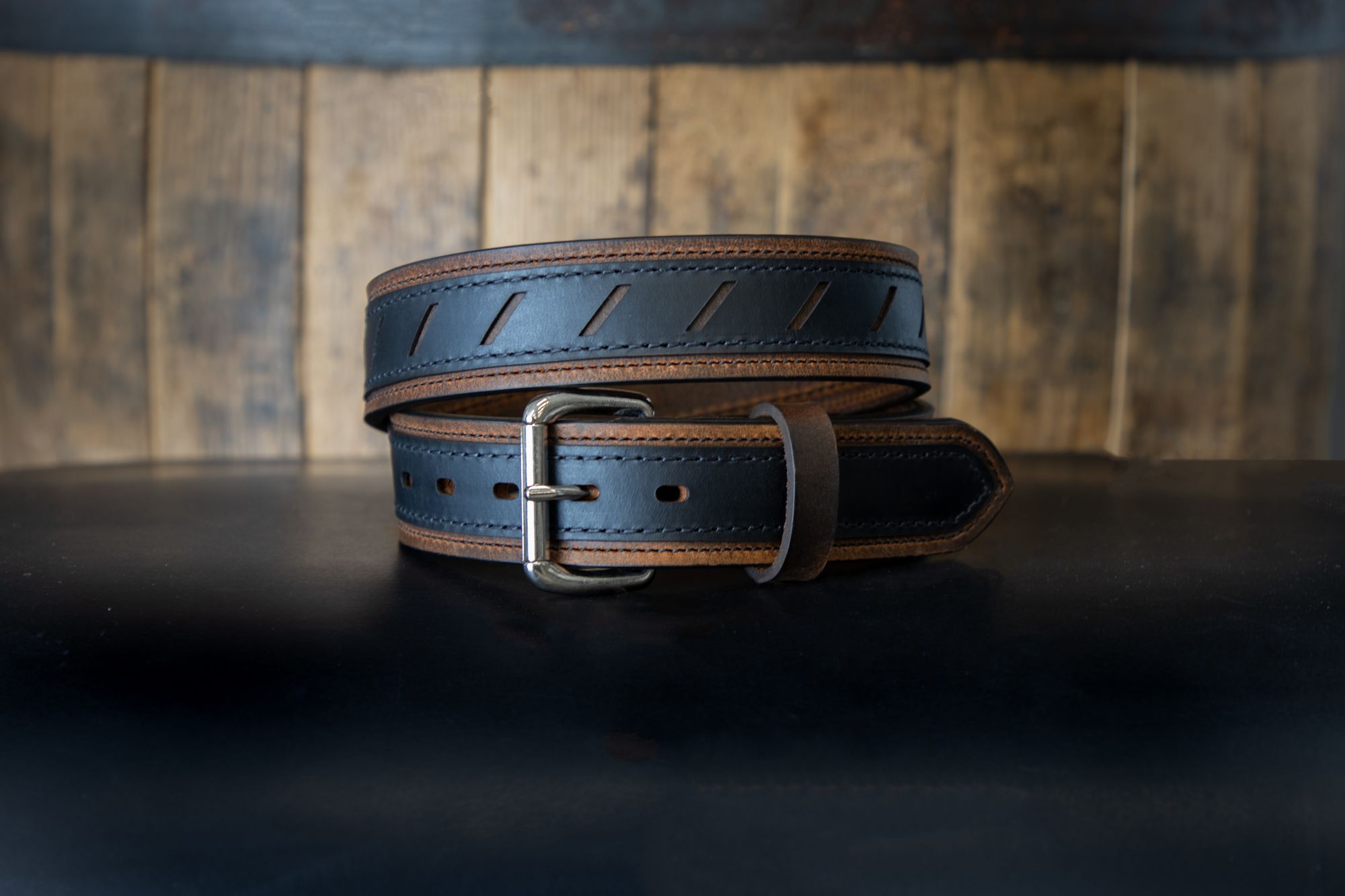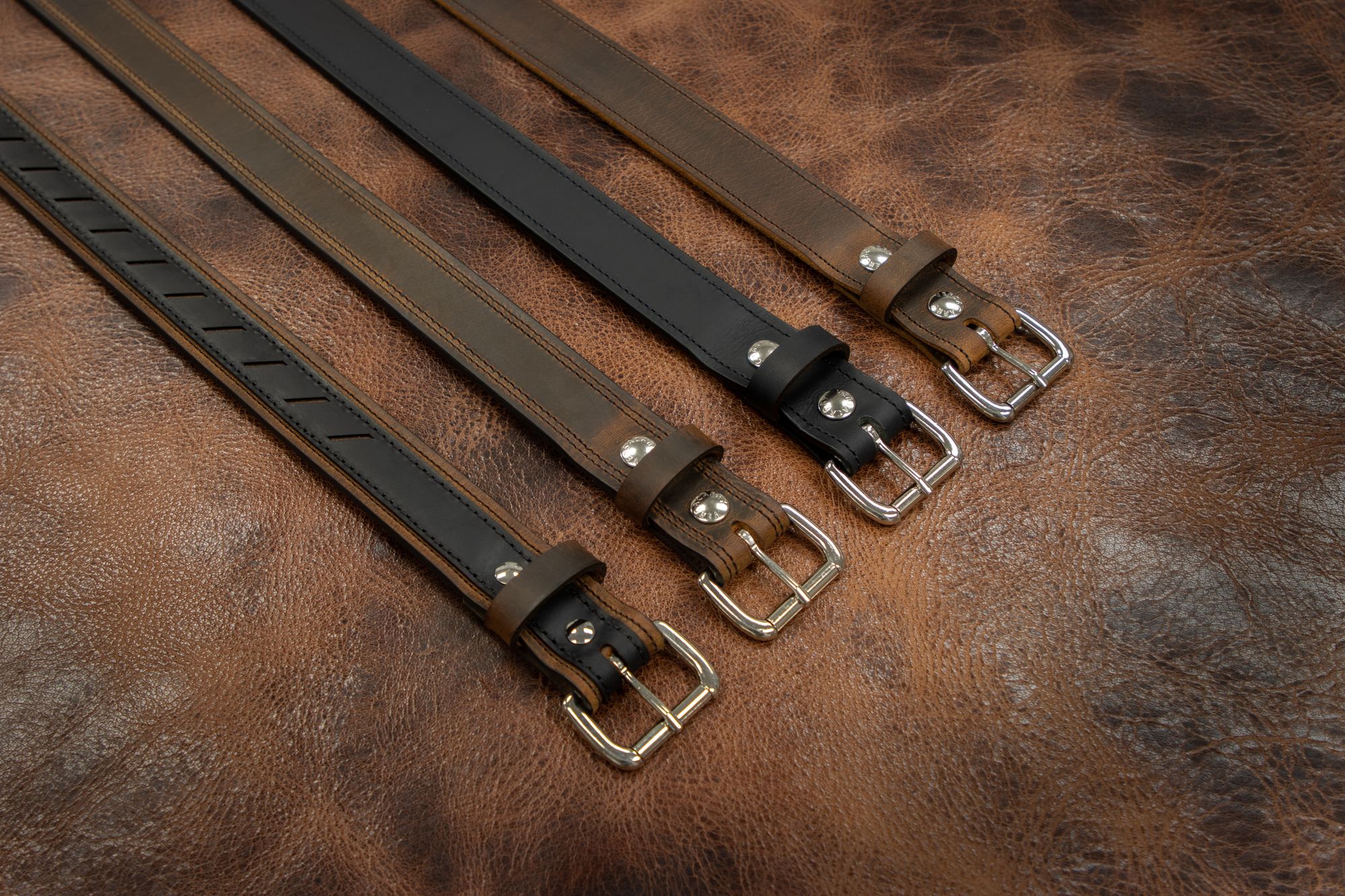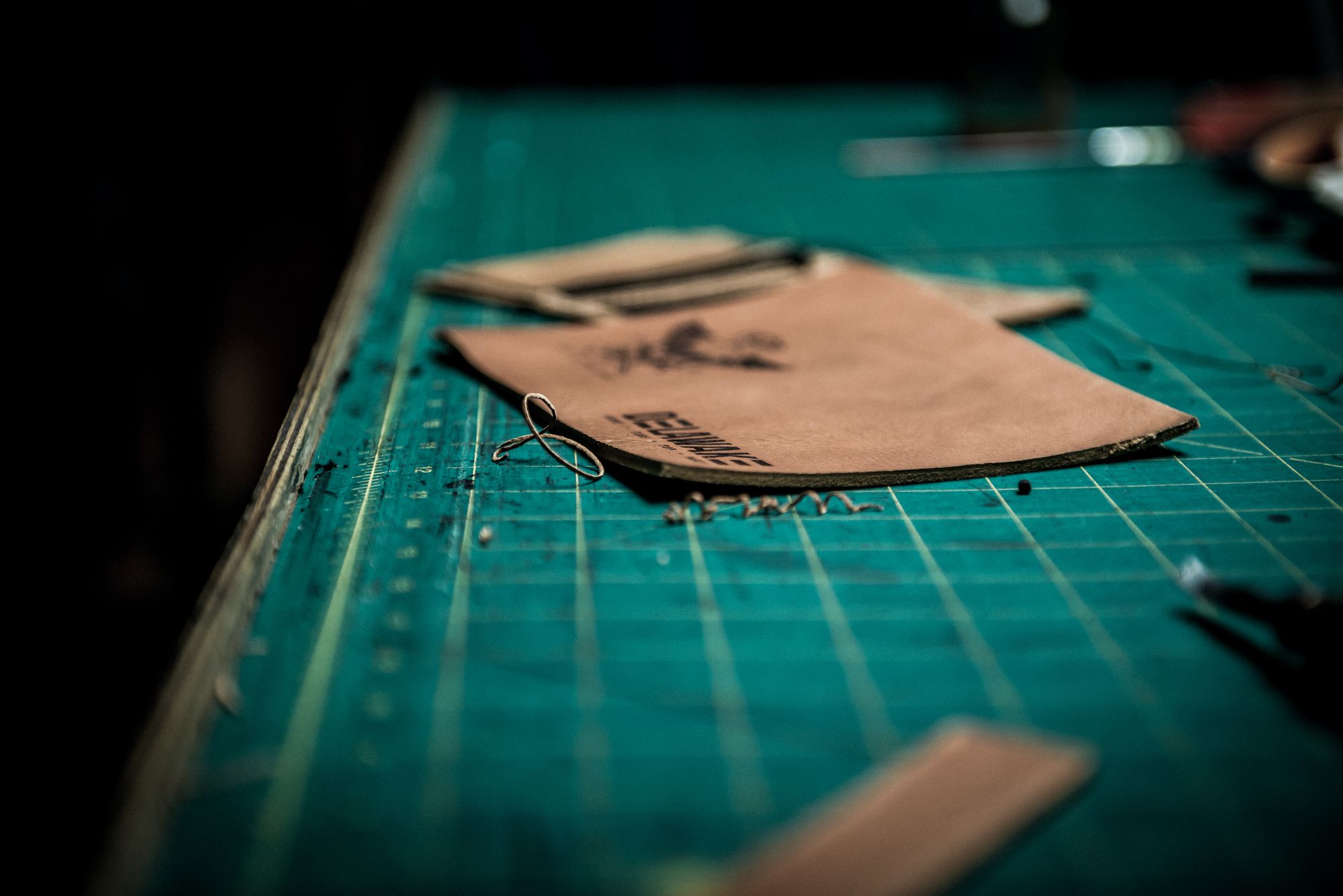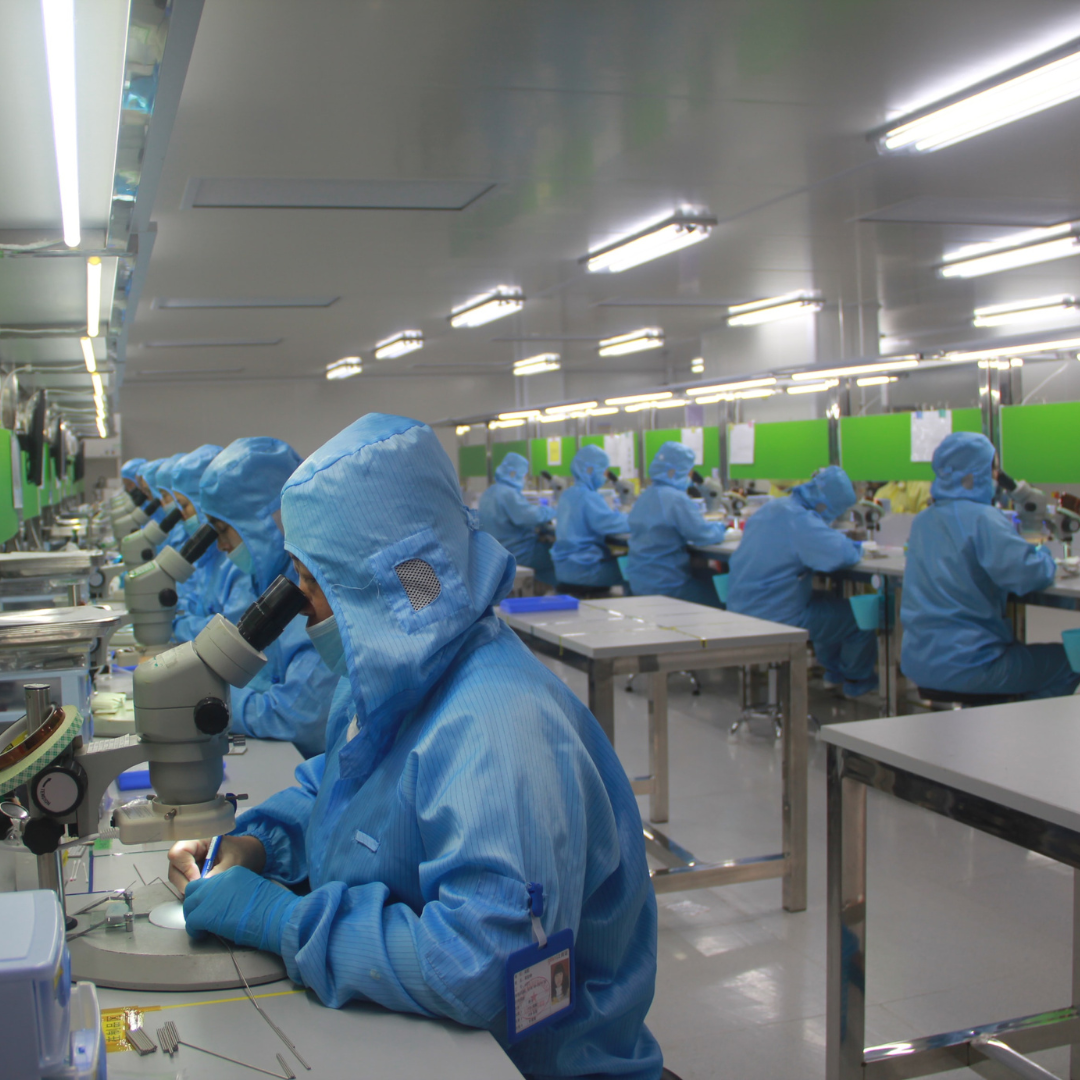Leather dyeing and coloring techniques have been integral to the leather manufacturing industry for centuries. The process of dyeing and coloring leather involves treating the animal hide with chemical substances that can alter its color, texture, and durability.
In the United States, the leather manufacturing industry is a crucial component of the country's economy, contributing significantly to the country's GDP and creating numerous job opportunities. In terms of product categories, footwear, and leather goods are the leading segments, accounting for 54.7% and 26.7% of the industry revenue, respectively.
As the leather manufacturing industry continues to expand, it is essential for manufacturers to stay up-to-date with the latest dyeing and coloring techniques to maintain a competitive edge.

In this article, we will explore various leather dyeing and coloring techniques that are commonly used in the industry and discuss their advantages and disadvantages.
Here's what we shall cover in this post:
- Introduction to Leather Dyeing and Coloring Techniques
- Types of Dyeing Methods Used in Leather Production
- Traditional Vegetable Tanning Processes
- Synthetic Tanning Agents and Their Effects on Leather
- The Role of pH in Leather Dyeing
- Techniques for Achieving Different Leather Colors
- Environmental Impact of Leather Dyeing Processes
- Energy Consumption in Leather Dyeing
- Sustainable Leather Dyeing Alternatives
- Trends and Innovations in Leather Dyeing and Coloring
- Conclusion
- Key Takeaways
Introduction to Leather Dyeing and Coloring Techniques
Leather dyeing and coloring techniques are methods of changing the color of the leather to suit personal preferences or to achieve a particular look.
- Many different types of dyes and coloring agents are available for leather, each with unique properties and effects.
- Some popular leather dyes include water-based dyes, oil-based dyes, and alcohol-based dyes, each with advantages and disadvantages.
- Leather can be dyed using a variety of techniques, such as spray dyeing, hand dyeing, and dip-dyeing.
- When dyeing leather, following the manufacturer's instructions and using the appropriate tools and equipment to ensure a smooth and even application is essential.
- Before dyeing leather, it should be thoroughly cleaned and prepped to remove any dirt, oil, or other contaminants that might affect the dye's absorption.
- Once the leather has been dyed, it should be allowed to dry completely before it can be finished or polished.
- Using the proper techniques and tools makes it possible to create a wide range of colors and finishes on leather, from subtle tonal variations to bold, vibrant hues.
- Leather dyeing and coloring techniques are essential skills for anyone who works with leather, whether for fashion, upholstery, or other applications.
Types of Dyeing Methods Used in Leather Production
Following are some of the most common types of dyeing methods used in leather production.
Drum Dyeing
Drum dyeing is a popular method for dyeing large quantities of leather at once. This method involves placing the leather into a drum along with the dye and allowing it to rotate for several hours. The dye penetrates the leather fibers, resulting in a uniform color. Drum dyeing is often used for leather that will be used for upholstery or car interiors, where color consistency is important.
The process begins by soaking the leather in water to prepare it for the dye. The dye is then added to the drum along with the leather, and the drum is rotated for several hours until the desired color is achieved. Once the dyeing process is complete, the leather is removed from the drum and dried.
- Process of Drum Dyeing: The process involves preparing a dye bath solution suitable for the type of leather being dyed. The dye solution is then poured into a rotating drum that is large enough to accommodate the quantity of leather being dyed. The leather is then placed into the drum, and the drum is rotated for a set amount of time to ensure that the dye is absorbed evenly. The leather is then removed from the drum and rinsed to remove any excess dye.
- Advantages of Drum Dyeing: Drum dyeing is a highly efficient method of dyeing leather. It allows for large quantities of leather to be dyed uniformly, saving time and reducing costs. The method also allows for a wide range of colors to be produced, making it ideal for producing leather for a variety of products.
- Types of Leather Suitable for Drum Dyeing: The drum dyeing method is suitable for a wide range of leather types, including full-grain, top-grain, and corrected-grain leather. However, it is not recommended for use with suede or nubuck leathers, as these leathers are more delicate and can be easily damaged during the process.
- Precautions for Drum Dyeing: While drum dyeing is a highly efficient method of dyeing leather, there are some precautions that need to be taken to ensure that the process is carried out safely and effectively. It is essential to use the correct type and amount of dye for the leather being dyed, as using the wrong type of dye or too much dye can damage the leather. It is also important to monitor the temperature and pH of the dye bath solution to ensure that they remain within the recommended range.
- Environmental Concerns: While drum dyeing is an efficient method of dyeing leather, it can also have environmental implications. The process requires a significant amount of water and chemicals, which can lead to wastewater pollution if not properly managed. To address this issue, some leather manufacturers have implemented wastewater treatment systems to treat the water used in the drum dyeing process.
Hand Dyeing
Hand dyeing is a more precise method of dyeing leather that allows for more control over the color and shading. This method is often used by artisans and craftspeople who work with small quantities of leather. Hand dyeing involves applying the dye to the leather by hand, using a brush or sponge. The dye is applied in thin layers, allowing each layer to dry before applying the next.
Hand dyeing can be time-consuming, but it allows for more creativity and customization. Leather can be dyed to match a specific color scheme or to create unique shading and texture effects. Hand dyeing is also helpful in repairing leather items that have faded or lost their color over time.
Here are some key points highlighting the process and benefits of hand dyeing in leather production:
- Artistic Expression: Hand dyeing allows artisans and craftsmen to showcase their creativity and artistic skills. It offers a wide range of color possibilities, shades, and effects, allowing for unique and customized leather products. Artisans can create intricate patterns, gradients, blends, and other artistic designs, making each piece of dyed leather truly one-of-a-kind.
- Customization and Personalization: Hand dyeing enables manufacturers to offer personalized leather products tailored to individual customer preferences. Customers can choose specific colors, combinations, and designs, creating a sense of exclusivity and uniqueness. Hand-dyed leather products often have a personal touch that machine-dyed items may not be able to replicate.
- Enhancing Natural Characteristics: Hand dyeing can enhance the natural characteristics of the leather, such as grain patterns, texture, and depth. It allows the dye to penetrate the leather surface, highlighting its natural beauty and uniqueness. Hand-dyed leather products often exhibit variations and nuances in color, giving them a rich and organic appearance.
- Color Variations and Effects: Hand dyeing offers a wide range of color variations and effects that can be achieved through different techniques and dye application methods. Artisans can create solid colors, gradients, ombre effects, two-tone effects, antique finishes, and other unique color blends. This versatility allows for endless possibilities in leather design.
- Aging and Patina Development: Hand-dyed leather develops a natural aging and patina over time, which adds character and charm to the product. As the leather ages, the dye may fade, blend, or develop a vintage appearance, giving it a distinctive and lived-in look. This natural aging process can enhance the overall appeal and value of hand-dyed leather products.
- Sustainability: Hand dyeing can be a more sustainable alternative to certain industrial dyeing processes. With careful consideration of dye materials and application techniques, hand dyeing can reduce the environmental impact associated with chemical-intensive dyeing methods. Artisans can opt for natural or eco-friendly dyes and implement responsible waste management practices.
- Flexibility and Adaptability: Hand dyeing offers flexibility in terms of dye application and customization. Artisans can control the intensity of the dye, layer colors, blend shades, and adjust the dyeing process based on the desired outcome. This adaptability allows for experimentation and innovation, enabling artisans to create unique and visually appealing leather products.
- Craftsmanship and Heritage: Hand dyeing in leather production preserves traditional craftsmanship and heritage techniques. It reflects the artisan's skill, attention to detail, and dedication to producing high-quality leather goods. Hand-dyed leather products often carry a sense of authenticity and craftsmanship that appeals to customers seeking unique and artisanal products.
Spray Dyeing
Spray dyeing is a quick and efficient method for dyeing large areas of leather, such as furniture upholstery or clothing. This method involves applying the dye to the leather surface with a spray gun. Spray dyeing is often used for leather that has already been treated with a protective finish, as the dye can be applied without affecting the finish.
The dye is mixed with a solvent to spray dye leather to create a thin, even consistency. The mixture is then loaded into a spray gun and applied to the leather surface in thin, even layers. Multiple layers may be applied to achieve the desired color depth.
- Even Color Application: Spray dyeing ensures uniform color application across the entire surface of the leather. The fine mist of dye particles allows for better dispersion and penetration into the leather fibers, resulting in a smooth and even color distribution. This helps eliminate blotches or uneven patches that can occur with other dyeing methods.
- Efficient and Time-Saving: Spray dyeing is a highly efficient process, particularly for large-scale leather production. The use of spray guns or airbrushes allows for quick and precise application of dye, reducing production time compared to manual dyeing methods. The controlled spray pattern also ensures that the dye is applied only to the intended areas, minimizing wastage.
- Versatility in Color and Effects: Spray dyeing offers a wide range of color options and effects. Manufacturers can achieve solid colors, gradients, ombre effects, and other artistic designs by adjusting the concentration of the dye solution, spray pressure, or the distance between the spray gun and the leather surface. This versatility allows for creativity and customization in leather product design.
- Consistency and Reproducibility: Spray dyeing enables consistent color reproduction, making it ideal for large-scale production where color matching and consistency are crucial. Manufacturers can establish standard operating procedures (SOPs) for spray dyeing, ensuring that the same color shade and intensity can be achieved repeatedly. This consistency enhances product quality and customer satisfaction.
Dip Dyeing
Dip dyeing is a method of dyeing leather that involves submerging the leather into a dye solution. This method is often used for smaller leather items like wallets or keychains. Dip dyeing allows for the creation of a gradient effect, where the color gradually fades from one end of the leather to the other.
To dip dye leather, the leather is first soaked in water to prepare it for the dye. The dye solution is then prepared in a large container, and the leather is immersed into the solution. The leather is left in the solution for several minutes, allowing the dye to penetrate the fibers. The leather is then removed from the solution and rinsed with water to remove any excess dye.
- Immersion Process: Dip dyeing involves submerging the leather material into a dye bath or solution, allowing the color to penetrate the fibers. The leather is fully immersed, ensuring that the dye reaches all areas evenly. The duration of immersion determines the intensity of the color.
- Uniform Color Saturation: Dip dyeing offers excellent color saturation throughout the leather. As the material is fully submerged, the dye permeates the fibers, resulting in a uniform color intensity. This method is particularly effective for achieving deep and rich colors.
- Penetration and Absorption: One of the advantages of dip dyeing is that the dye penetrates the leather deeply, ensuring that the color is absorbed throughout the material. This allows for long-lasting color retention and resistance to fading or rubbing off.
- Color Blending and Gradient Effects: Dip dyeing also allows for color blending and gradient effects. By gradually immersing the leather at different depths or by dipping it multiple times in different dye solutions, manufacturers can create unique color transitions and ombre effects. This versatility adds aesthetic appeal to leather products.
Airbrushing
Airbrushing is a more advanced method of dyeing leather that allows for more precise color application. This method involves spraying the dye onto the leather surface using an airbrush. Airbrushing allows for the creation of intricate designs and patterns, making it popular for leather art and fashion.
The dye is mixed with a solvent to airbrush leather to create a thin, even consistency. The mixture is then loaded into an airbrush and applied to the leather surface in thin, even layers. Multiple layers may be applied to achieve the desired color depth and shading.
- Airbrushing Equipment: Airbrushing requires specialized equipment, including an airbrush gun, an air compressor, and a source of compressed air. The airbrush gun controls the flow of paint or dye, while the air compressor provides the necessary pressure to atomize the liquid into a fine spray.
- Control and Precision: Airbrushing allows for precise control over the application of color. The airbrush gun typically features adjustable settings for controlling the airflow and paint flow, enabling artists and craftsmen to achieve detailed and intricate designs on leather surfaces. The fine mist created by the airbrush provides a smooth and even application of color.
- Customization and Personalization: Airbrushing enables customization and personalization of leather products. It offers the flexibility to create unique designs, logos, names, or other personalized elements, making each piece of leather distinct and tailored to individual preferences. This customization adds value and uniqueness to leather goods.
- Color Options: Airbrushing provides a wide range of color options. Artists can mix and blend different paints or dyes to achieve custom colors or create subtle color transitions. The ability to layer colors allows for creating complex and vibrant designs on leather surfaces.
Traditional Vegetable Tanning Processes
Soaking
The first step in the vegetable tanning process is soaking the animal hides in water to remove any dirt or debris. This process can take several hours or even days, depending on the size and thickness of the hides.
During the soaking process, the hides begin to absorb water and expand, making them more pliable and easier to work with. This step is essential for preparing the hides for the tanning process.
Liming
After soaking, the hides are treated with lime to remove any remaining hair or flesh. Lime is a natural substance that helps break down the proteins in the hide, making removing unwanted materials easier.
The hides are soaked in a lime solution for several days during the liming process. The solution is then drained off, and the hides are washed and rinsed to remove any remaining lime.
There are two main types of liming used in vegetable tanning: traditional liming and modern liming. Traditional liming involves the use of natural materials such as lime and wood ash to create the alkaline solution. Modern liming involves the use of chemicals such as sodium sulfide and sodium hydroxide.
Deliming and Bating
After the liming process, the hides are treated with a deliming agent to neutralize the lime and restore the natural pH balance of the hides. This step is essential for preparing the hides for the tanning process.
After deliming, the hides are then treated with a bating agent, which helps soften and condition the hides. This step is essential for creating a soft, supple leather that is comfortable to wear or use.
Purpose of Deliming:
Deliming is the process of removing the limed hair and excess lime from the hides. The purpose of deliming is to bring the pH of the hides down to the optimal range for the bating process. Deliming is accomplished by soaking the hides in a solution of water and an acid such as sulfuric acid, formic acid, or lactic acid. The acid neutralizes the lime and removes it from the hides.
Bating process:
Bating is the process of removing the remaining flesh and connective tissue from the hides. This process is necessary to prepare the hides for tanning. Bating also helps to open up the fibers of the hide so that they can absorb the tanning agents more effectively. There are two methods of bating: enzymatic bating and chemical bating.
Enzymatic Bating:
Enzymatic bating is a natural process that uses enzymes to break down the remaining flesh and connective tissue on the hides. This process is slower than chemical bating, but it is gentler on the hides and produces a more natural-looking leather. The enzyme used for bating is usually derived from a fungal source.
Chemical Bating:
Chemical bating is a faster process that uses chemicals to break down the remaining flesh and connective tissue on the hides. The chemicals used for bating are usually a mixture of sodium sulfide, sodium hydrosulfide, and other reducing agents. This process is faster and more efficient than enzymatic bating, but it can be harsher on the hides and can produce a more processed-looking leather.
Importance of Deliming and Bating:
Deliming and bating are crucial steps in the traditional vegetable tanning process. These processes help to prepare the hides for tanning by removing the hair, flesh, and excess lime. This makes the hides more receptive to the tanning agents and helps to produce a more even and consistent leather. The deliming and bating process can also affect the final quality of the leather, so it is important to get these steps right.
Tanning
The tanning process is the most critical step in vegetable tanning. During this process, the hides are immersed in a solution of natural tannins derived from tree bark, leaves, and other plant materials.
The tannins bind to the collagen fibers in the hides, creating a durable and long-lasting material that is resistant to water, heat, and other environmental factors. The tanning process can take several weeks or even months, depending on the desired quality and properties of the leather.
Drying and Conditioning
After the tanning process, the hides are then dried and conditioned. The drying process can take several days, during which the hides are hung in a cool, dry place to prevent any cracking or damage.
Once the hides are dry, they are then conditioned with natural oils and fats to restore their suppleness and softness. This step is essential for creating high-quality leather that is comfortable to wear or use.
Finishing
After conditioning, the leather is then finished with natural dyes and finishes to enhance its appearance and durability. Natural dyes are derived from plant materials, such as roots, berries, and leaves, and can create a wide range of colors and hues.
Natural finishes, such as beeswax or carnauba wax, are applied to the leather to create a protective barrier that helps prevent damage from water, dirt, and other environmental factors.
Mineral Tanning Processes for Leather Coloring
Mineral tanning is a process used to produce durable and water-resistant leather. Unlike vegetable tanning, which relies on natural substances, mineral tanning uses chemicals to transform animal hides into leather.
Chromium Tanning
Chromium tanning is the most common mineral tanning process used today. During this process, the hides are treated with chromium salts, which help bind the collagen fibers in the hides and create a durable and water-resistant material.
Chromium tanning is a relatively quick and efficient process that produces leather with a uniform color and texture. However, some people have concerns about the environmental impact of chromium tanning and the potential health risks associated with exposure to chromium.
- The Process: Chromium tanning is a mineral tanning process that involves the use of chromium salts as the tanning agent. The process usually begins by soaking the raw hides or skins in a salt solution that contains chromium salts. The chromium ions then penetrate the hides and bind with the collagen fibers, resulting in a stable and durable leather product.
- Benefits: Chromium tanning is preferred by many leather manufacturers because it is a relatively fast process that results in a soft and uniform leather product. The leather produced using chromium tanning is resistant to water, heat, and other environmental factors, making it ideal for a wide range of applications, including shoes, bags, and furniture.
- Environmental Concerns: Despite its popularity, chromium tanning is known to be an environmentally hazardous process. The chromium salts used in the tanning process can cause pollution and are classified as hazardous waste material. This has led to regulations and restrictions on the use of chromium tanning in many countries around the world.
Alum Tanning
Alum tanning is an ancient method of mineral tanning that has been used for centuries. During this process, the hides are treated with a solution of alum, which is a naturally occurring mineral.
Alum Tanning produces soft and flexible leather with a pale yellow color. However, it is not as durable or water-resistant as chromium-tanned leather.
Advantages of alum tanning
Alum tanned leather is known for its light color, softness, and flexibility. It is also water resistant, making it ideal for use in humid climates or wet environments. In addition, alum tanned leather is less likely to crack or shrink, which makes it ideal for use in clothing and accessories.
Disadvantages of alum tanning
One of the main disadvantages of alum tanning is that it can be time-consuming and labor-intensive. The process of soaking the hides in the alum solution can take several weeks, and requires constant monitoring to ensure that the hides are properly tanned. In addition, alum tanned leather is not as durable as leather that has been tanned using other methods, which makes it less suitable for use in high-impact applications.
Zirconium Tanning
Zirconium tanning is a relatively new method of mineral tanning that is gaining popularity in the leather industry. During this process, the hides are treated with zirconium salts, which help bind the collagen fibers in the hides and create a durable and water-resistant material.
Zirconium tanning is considered to be a more environmentally friendly alternative to chromium tanning, as it produces fewer harmful byproducts. However, it is still a relatively new process, and its long-term effects on the environment and human health are not yet fully understood.
Benefits of zirconium tanning
Zirconium tanning offers several benefits over traditional tanning methods. Firstly, it is a relatively quick process that takes only a few hours compared to several days required for other tanning methods. Secondly, it uses fewer chemicals, making it more environmentally friendly. Additionally, the resulting leather is lightweight and has a soft, supple feel.
Titanium Tanning
Titanium tanning is another alternative to chromium tanning that is gaining popularity in the leather industry. During this process, the hides are treated with titanium salts, which help bind the collagen fibers in the hides and create a durable and water-resistant material.
Titanium tanning produces leather with a soft, supple texture and a uniform color. It is also considered to be more environmentally friendly than chromium tanning, as it produces fewer harmful byproducts.
Benefits of Titanium Tanning
There are several benefits of using titanium tanning over other tanning methods. Firstly, titanium tanning does not produce hazardous waste, unlike traditional chrome tanning methods. This makes it an environmentally friendly option. Secondly, titanium tanning produces leather that is softer and more pliable than chrome-tanned leather. This is because the tanning process does not shrink the collagen fibers in the leather.
Iron Tanning
Iron tanning is an ancient method of mineral tanning that has been used for centuries. During this process, the hides are treated with a solution of iron salts, which help bind the collagen fibers in the hides and create a durable and water-resistant material.
Iron tanning produces soft and flexible leather with a reddish-brown color. However, it is not as durable or water-resistant as chromium-tanned leather.
- Advantages of Iron Tanning: Iron tanning is a relatively inexpensive method of tanning leather compared to other methods, such as chrome tanning. It is also a more environmentally friendly process as it does not produce toxic waste products. Iron-tanned leather is also more durable and resistant to water than vegetable-tanned leather.
- Disadvantages of Iron Tanning: Iron-tanned leather is not as supple or soft as leather tanned with other methods, which can make it less suitable for certain applications such as clothing. It may also be more difficult to dye iron-tanned leather as iron salts can interfere with the absorption of the dye.
- Applications of Iron Tanning: Iron-tanned leather is commonly used in the production of shoe leather, belt leather, and other types of leather goods that require durability and water resistance. It is also used in the manufacture of bookbinding leather and for industrial purposes such as conveyor belts.
Synthetic Tanning Agents and Their Effects on Leather
Leather tanning is the process of transforming raw animal hides into durable, long-lasting leather. While traditional tanning methods involve natural substances like plant extracts and minerals, synthetic tanning agents are also used in modern tanning processes.
Synthetic Tanning Agents
Synthetic tanning agents are chemical compounds that are used to transform animal hides into leather. These compounds are typically derived from petroleum or other sources and can be more efficient and cost-effective than traditional tanning methods.
Some common synthetic tanning agents include:
- Acrylic Tanning Agents:
Acrylic tanning agents are the most widely used synthetic tanning agents in the leather industry. These agents provide excellent color, softness, and improved water resistance to leather. They are also resistant to heat and light, making them ideal for use in high-performance leathers.
- Melamine-Formaldehyde Tanning Agents:
Melamine-formaldehyde tanning agents are used for the production of high-quality leather. They offer superior light-fastness, water resistance, and excellent heat stability. These agents are commonly used for the production of shoe uppers, garments, and upholstery leathers.
- Phenol-Formaldehyde Tanning Agents:
Phenol-formaldehyde tanning agents are used to produce soft, flexible, and durable leathers. They are also resistant to water and abrasion, making them suitable for use in a variety of applications. These agents are commonly used in the production of shoe uppers, garments, and upholstery leathers.
- Sulfone Tanning Agents:
Sulfone tanning agents are used to produce leathers that are resistant to heat and light, as well as water and abrasion. They offer excellent color and softness, making them ideal for use in high-end leathers. These agents are commonly used in the production of shoe uppers, garments, and upholstery leathers.
- Polyurethane Tanning Agents:
Polyurethane tanning agents are used to produce soft, flexible, and durable leathers. They offer excellent water resistance and are resistant to abrasion and light. These agents are commonly used in the production of shoe uppers, garments, and upholstery leathers.
Effects of Synthetic Tanning Agents on Leather
While synthetic tanning agents can be effective in producing high-quality leather, they can also have negative effects on the leather's properties. Here are some potential effects of synthetic tanning agents on leather:
- Reduced breathability: Synthetic tanning agents can reduce the leather's breathability, which can make it less comfortable to wear.
- Reduced flexibility: Some synthetic tanning agents can make the leather stiffer and less flexible, which can affect its overall durability and wearability.
- Reduced water resistance: Synthetic tanning agents may not provide the same level of water resistance as natural tanning methods, which can affect the leather's durability and lifespan.
- Reduced color fastness: Synthetic tanning agents can affect the leather's ability to retain its color over time, which can lead to fading or discoloration.
Advantages of Synthetic Tanning Agents
Despite these potential drawbacks, synthetic tanning agents do have some advantages over natural tanning methods. Here are a few reasons why synthetic tanning agents are used in the leather industry:
- Consistency in Quality: One of the biggest advantages of synthetic tanning agents is their consistency in quality. Unlike traditional tanning methods, which can vary in quality depending on the source and method of extraction, synthetic tanning agents provide a consistent quality of leather. This consistency is particularly important for high-end leather goods where quality is paramount.
- Increased Speed of Tanning: Another advantage of synthetic tanning agents is their ability to tan leather quickly. Traditional tanning methods can take weeks or even months to tan leather properly, whereas synthetic tanning agents can complete the process in a matter of hours or days. This speed is particularly useful for large-scale leather production where time is critical.
- Reduced Environmental Impact: Synthetic tanning agents are also advantageous because they have a lower environmental impact compared to traditional tanning methods. Synthetic tanning agents are designed to be more eco-friendly, releasing fewer pollutants into the environment. This is particularly important in today's world, where environmental concerns are at an all-time high.
- Improved Control Over the Tanning Process: Synthetic tanning agents allow for greater control over the tanning process. Leather tanned using traditional methods can vary in quality, color, and texture, but synthetic tanning agents allow for greater control over these factors. This greater control allows leather manufacturers to create leather that meets specific requirements and standards.
- Increased Durability of Leather: Another advantage of synthetic tanning agents is their ability to increase the durability of leather. Leather tanned using synthetic tanning agents has a higher resistance to water, heat, and wear and tear. This increased durability makes it ideal for leather products that are used in harsh environments, such as outdoor gear and footwear.
Choosing the Right Tanning Agent
When it comes to choosing a tanning agent for leather, there is no one-size-fits-all solution. The choice of tanning agent depends on a variety of factors, including the desired properties of the leather, the intended use of the finished product, and the environmental impact of the tanning process.
The Role of pH in Leather Dyeing
The pH level of a solution plays a crucial role in many chemical processes, including leather dyeing.
pH Basics
pH is a measure of the acidity or alkalinity of a solution. The pH scale ranges from 0 to 14, with 0 being the most acidic, 14 being the most alkaline, and 7 being neutral.
In leather dyeing, the pH level of the dye solution can significantly impact the final color and quality of the leather.
pH and Dye Color
The pH level of a dye solution can affect the color of the leather in several ways. Here are a few examples:
- Acidic dyes: Acidic dyes are most effective in acidic environments, typically with a pH between 4 and 5. Acidic dyes may not bond well with the leather at higher pH levels, leading to uneven or muted colors.
- Basic dyes: Basic dyes are most effective in alkaline environments, typically with a pH between 8 and 9. Basic dyes may not bond well with the leather at lower pH levels, leading to uneven or muted colors.
- Neutral dyes: Neutral dyes can work in a range of pH levels, typically between 6 and 7. These dyes are often used in combination with other dyes to achieve specific shades and hues.
pH and Leather Quality
In addition to affecting the color of the leather, the pH level of the dye solution can also impact the quality of the leather. Here are a few examples:
- pH and tannins: Tannins are natural substances found in many plants that are used in leather tanning. Tannins are most effective in acidic environments, typically with a pH between 4 and 5. Tannins may not bond well with the leather at higher pH levels, leading to weaker and less durable leather.
- pH and protein structure: Leather is made up of protein fibers that can be affected by changes in pH. Excessive exposure to alkaline solutions can weaken the protein fibers in the leather, leading to weaker and less durable leather.
Achieving the Right pH Level
To achieve optimal results in leather dyeing, it's essential to maintain the correct pH level throughout the dyeing process. Here are a few tips for achieving the right pH level:
- Test the pH: Before dyeing leather, test the pH level of the dye solution to ensure that it is within the appropriate range for the dye being used.
- Adjust the pH: If the pH level is too high or too low, adjust it using an appropriate acid or base. Common acids used for adjusting pH in leather dyeing include acetic acid and formic acid, while common bases include sodium carbonate and sodium hydroxide.
- Monitor the pH: Throughout the dyeing process, monitor the pH level of the dye solution to ensure that it remains within the appropriate range. Small adjustments may be necessary to maintain the correct pH level.
Techniques for Achieving Different Leather Colors
Vegetable Tanning
Vegetable tanning is a traditional method of leather tanning that uses natural tannins found in plant materials to color and preserve the leather. This method typically results in a range of brown shades, from light tan to dark brown. With vegetable tanning, the color of the leather depends on the type and quality of the tannins used and the duration of the tanning process.
Natural Tannins: Vegetable tanning relies on the natural tannins found in various plant materials, such as tree barks, leaves, and fruits. Common sources of tannins include oak, chestnut, mimosa, quebracho, and tara.
Tannin Extraction: Tannins are extracted from the plant materials by soaking them in water or extracting them through various extraction methods. The extracted tannins are then processed into a liquid form that can be used for tanning.
Color Development: During the tanning process, the tannins react with the collagen in the hide, resulting in the development of a rich, natural color. The color can range from light beige to various shades of brown, depending on the type of tannin used and the duration of the tanning process.
Patina and Aging: One of the unique characteristics of vegetable-tanned leather is its ability to develop a beautiful patina over time. As the leather ages and is exposed to light, air, and natural oils, it darkens and acquires a unique sheen and character.
Mineral Tanning
Mineral tanning is another traditional method of leather tanning that uses mineral salts, such as chromium, to color and preserve the leather. Unlike vegetable tanning, mineral tanning can produce a wide range of colors, including black, brown, and a variety of other hues. The color of the leather can be controlled by adjusting the pH level of the tanning solution.
Chromium Salts: Mineral tanning primarily relies on the use of chromium salts, particularly chromium sulfate, chromium chloride, or a combination of both. These salts contain trivalent chromium, which is essential for the tanning process.
Tanning Process: In mineral tanning, the raw hides or skins are soaked in a tanning solution containing the chromium salts. The tanning solution is typically acidic to facilitate the penetration of the chromium ions into the collagen fibers of the hide.
Crosslinking: The chromium ions form strong crosslinks with the collagen fibers in the hide, stabilizing the structure and preventing it from deteriorating. This process is known as crosslinking, and it imparts durability, strength, and stability to the leather.
Synthetic Dyes
Synthetic dyes are popular for coloring leather due to their versatility and ease of use. These dyes can produce a wide range of colors, from classic browns and blacks to bold and bright hues. Synthetic dyes can be applied to leather using a variety of methods, including immersion dyeing, spray dyeing, and hand painting.
Color Consistency: Synthetic dyes offer excellent color consistency, allowing manufacturers to achieve precise and predictable shades in leather coloring. They provide a broader spectrum of colors compared to natural dyes, including vibrant and intense hues.
Colorfastness: Synthetic dyes are known for their superior colorfastness, which refers to the ability of the color to remain stable and resistant to fading or bleeding over time. Leather dyed with synthetic dyes maintains its color integrity even with exposure to light, heat, and other external factors.
Wide Range of Colors: Synthetic dyes offer an extensive palette of colors, providing endless possibilities for leather manufacturers to create unique and customized products. From bold and vivid shades to subtle and pastel tones, synthetic dyes allow for versatile and creative leather coloring.
Cost-Effective: Synthetic dyes are generally more cost-effective compared to natural dyes. They are often produced in large quantities, making them readily available and affordable for manufacturers. This cost advantage contributes to the widespread use of synthetic dyes in the leather industry.
Pigment Dyes
Pigment dyes are another popular choice for coloring leather, particularly for achieving bold and vibrant colors. Pigment dyes are typically applied as a coating on top of the leather rather than penetrating the fibers like traditional dyes. This allows for more control over the color and opacity of the finished product.
Color Variety: Pigment dyes provide a wide range of colors, including vibrant shades and deep tones. Manufacturers can easily achieve intense and bold colors with pigments, allowing for diverse design options and customization in leather products.
Colorfastness: Pigment dyes are known for their exceptional colorfastness. Once applied and properly fixed, the pigments exhibit excellent resistance to fading or bleeding, even when exposed to sunlight, heat, or other environmental factors. This ensures that the color remains vibrant and stable over time.
Versatility: Pigment dyes are versatile and can be used on a variety of leather types, including full-grain, top-grain, and corrected-grain leathers. They can also be applied to leather with different finishes, such as aniline, semi-aniline, or pigmented finishes.
Surface Effect: Pigment dyes create a surface effect on the leather, providing a smooth and consistent appearance. They can help hide natural variations in the leather, such as scars, blemishes, or grain inconsistencies, resulting in a more uniform and aesthetically pleasing final product.
Ombre Dyeing
Ombre dyeing is a technique that involves gradually blending two or more colors to create a gradient effect. This technique can be used with both traditional and synthetic dyes and can produce stunning results on leather accessories like bags and belts.
Gradient Effect: Ombre dyeing creates a gradient effect on the leather, where the color gradually changes from light to dark or from one color to another. The transition can be smooth and subtle or more dramatic, depending on the desired effect.
Customization: Ombre dyeing allows for customization and unique design possibilities. By selecting different colors or shades, manufacturers can create personalized and eye-catching leather products. This technique offers versatility in creating various ombre effects, such as vertical, horizontal, or diagonal gradients.
Dye Application: Ombre dyeing can be achieved through various dye application methods. One common technique is to start with a lighter color and gradually darken it by applying multiple layers of dye. This can be done by hand, using brushes, sponges, or spray guns, to carefully blend the colors together.
Antiquing
Antiquing is a technique that involves distressing leather to give it an aged or vintage look. This can be achieved using a variety of methods, including dyeing the leather with a mixture of colors and then sanding or rubbing it to create a worn effect.
Techniques and Materials: Various techniques and materials can be used for antiquing leather. Some common methods include hand-rubbing, sponge or brush application, and spraying. The choice of materials includes dyes, pigments, glazes, and finishes specifically formulated for antiquing effects.
Highlighting and Darkening: Antiquing involves highlighting certain areas and darkening others to create depth and visual interest. Highlighting is achieved by applying lighter shades of dyes or pigments to specific areas, such as edges, creases, or raised surfaces, to simulate wear.
Darkening is done by applying darker shades or layers of dyes or pigments to recessed areas or overall surfaces to give an aged or weathered look.
Blending and Patina: Proper blending of colors is crucial in antiquing to achieve a natural and realistic appearance. Blending techniques like dry brushing or wet blending can be used to seamlessly blend different shades and create a smooth transition between colors.
This helps in achieving an authentic patina, which is the natural color change that occurs over time on leather.
Laser Etching
Laser etching is a more modern technique that involves using lasers for etching designs or patterns into the surface of the leather. This technique can be used to create intricate designs and can be combined with dyeing techniques to produce unique and eye-catching leather products.
Laser Technology: Laser etching utilizes the precision and control of laser technology to create detailed and precise designs on leather. High-powered lasers are used to generate a focused beam of light that interacts with the surface of the leather, resulting in controlled ablation or removal of the material.
Design Customization: Laser etching offers a high degree of design customization. Various software programs and computer-aided design (CAD) tools are used to create or import digital designs or patterns. These designs can be manipulated, scaled, or modified to meet specific requirements, allowing for endless possibilities in leather decoration.
Durability: Laser-etched designs on leather are highly durable and resistant to fading, peeling, or wearing off. The laser removes a thin layer of the leather's surface, exposing the underlying layers that retain the design. This ensures that the etched pattern remains intact even with regular use and exposure to environmental factors.
Foiling
Foiling is a technique that involves applying metallic foil to the surface of the leather to create a shiny, reflective finish. This technique can be used with a variety of colors and can add a touch of glamour to leather accessories like shoes and handbags.
Foil Selection: Foils used in leather foiling are typically made of metallic or glossy materials, such as gold, silver, copper, or various vibrant colors. The foils come in rolls or sheets and are available in different finishes, including matte, glossy, holographic, or patterned.
Adhesive Application: To achieve proper adhesion, a special adhesive or foil transfer layer is applied to the leather surface. The adhesive is typically heat-activated and designed to securely bond the foil to the leather.
Foil Transfer: The foil is placed over the adhesive-coated leather, with the metallic or glossy side facing up. The foil is then pressed onto the leather using a heat press machine or a hot stamping tool. The heat and pressure cause the foil to adhere to the adhesive layer, allowing the metallic or glossy finish to transfer onto the leather surface.
Colorfastness and the Importance of Testing
Colorfastness is a crucial aspect of leather production and is essential to ensure that the color of the leather remains stable and does not fade or change over time. Colorfastness is the ability of a material to maintain its color when exposed to various factors, such as light, water, and friction.
Importance of Colorfastness
Colorfastness is essential in leather production as it ensures that the leather maintains its color over time and does not fade or change. Without colorfastness, leather products can quickly lose their appeal and may become unsellable.
- Maintaining Appearance: Colorfastness is crucial for maintaining the appearance of leather products. Leather is often used in high-end products, and maintaining the color and quality of the material is essential for the product's longevity. If the leather starts to fade or lose its color quickly, it can significantly reduce the product's aesthetic appeal, making it look old and worn out.
- Durability: Colorfastness is also crucial for ensuring that leather products are durable. Leather is a naturally durable material, and with proper care, it can last for many years. However, if the leather starts to fade or lose its color quickly, it can weaken the material, making it more susceptible to cracking and tearing. This can significantly reduce the lifespan of the product and require more frequent replacements.
- Protection Against Environmental Factors: Leather is often exposed to various environmental factors such as sunlight, water, and chemicals. Exposure to these factors can cause the leather to fade or lose its color quickly. However, if the leather is colorfast, it can better withstand these environmental factors, ensuring that the color remains vibrant and the leather remains durable.
- Customer Satisfaction: Colorfastness is also essential for ensuring customer satisfaction. When customers purchase leather products, they expect the color to remain vibrant and the product to be durable. If the leather starts to fade or lose its color quickly, it can lead to customer dissatisfaction, resulting in negative reviews, decreased sales, and a damaged reputation for the manufacturer.
- Cost-Effectiveness: Colorfastness is also crucial for ensuring that leather products are cost-effective. If the leather starts to fade or lose its color quickly, it can significantly reduce the product's lifespan, resulting in more frequent replacements and increased costs for the customer. By ensuring that the leather is colorfast, manufacturers can provide customers with high-quality, durable products that will last for many years, resulting in greater customer satisfaction and fewer replacement costs.
Factors Affecting Colorfastness
Several factors can affect the colorfastness of leather, including light, water, heat, and friction. Exposure to UV light can cause fading, while exposure to water and heat can cause the color to bleed or transfer. Friction can also cause the color to fade or wear away over time.
Testing Methods
There are several testing methods used to determine the colorfastness of leather, including the following:
- Lightfastness testing: This method involves exposing the leather to UV light for a specified period and then evaluating the color change using a grayscale.
- Water resistance testing: This method involves immersing the leather in water for a specified period and then evaluating the color change using a grayscale.
- Rubbing resistance testing: This method involves rubbing the leather with a standardized cloth or abrasive paper and evaluating the color change using a grayscale.
- Perspiration resistance testing: This method involves exposing the leather to artificial perspiration for a specified period and then evaluating the color change using a grayscale.
- Heat resistance testing: This method involves exposing the leather to high temperatures for a specified period and then evaluating the color change using a grayscale.
Standards and Regulations
There are several standards and regulations governing colorfastness testing in the leather industry, including those established by the International Organization for Standardization (ISO), the American Society for Testing and Materials (ASTM), and the European Committee for Standardization (CEN). These standards ensure that testing procedures are standardized and that the results are reliable and reproducible.
Implications for Leather Manufacturers
Colorfastness testing is crucial for leather manufacturers as it helps ensure that their products meet the necessary quality standards and regulations. By testing their products for colorfastness, manufacturers can identify potential issues early on and make any necessary adjustments to ensure that their products meet the required standards. This, in turn, can help protect their reputation and prevent costly product recalls.
Environmental Impact of Leather Dyeing Processes
Chemicals Used in Leather Dyeing
Leather dyeing typically involves the use of various chemicals, including chromium, heavy metals, and formaldehyde. These chemicals can be harmful to the environment and human health, particularly if not disposed of properly. Chromium, for example, is a known carcinogen and can cause serious health problems if ingested or inhaled.
Water Pollution
Leather dyeing can also contribute to water pollution. The chemicals used in the dyeing process can enter the water supply and pollute nearby bodies of water, such as rivers and streams. This pollution can have serious consequences for aquatic life and the ecosystem as a whole.
Air Pollution
Leather dyeing can also contribute to air pollution. The use of chemicals in the dyeing process can result in the emission of volatile organic compounds (VOCs), which can contribute to smog and other air quality issues.
Waste Generation
Leather dyeing can generate significant amounts of waste, including wastewater, solid waste, and hazardous waste. The disposal of this waste can be challenging and expensive, particularly if it contains dangerous chemicals.
Sustainable Leather Dyeing
Several sustainable dyeing methods are being developed to reduce the environmental impact of leather dyeing. These methods aim to reduce or eliminate the use of harmful chemicals and minimize waste generation. For example, natural dyes made from plants, fruits, and other organic materials are being used as alternatives to synthetic dyes.
Closed-Loop Systems
Another approach to sustainable leather dyeing is the use of closed-loop systems. In this system, wastewater from the dyeing process is treated and recycled back into the process. This reduces water consumption and minimizes the amount of wastewater generated.
Recycling and Upcycling
Recycling and upcycling are also becoming popular in the leather industry as a way to reduce waste. Leather scraps and waste can be recycled into new products or upcycled into new materials, reducing the need for virgin materials.
Government Regulations
Government regulations can also play a role in reducing the environmental impact of leather dyeing. Regulations can limit the use of certain chemicals and require the implementation of sustainable practices. For example, the European Union has established the REACH regulation, which restricts the use of certain chemicals in leather production.
Water Usage and Management in Leather Dyeing
Water usage and management in leather dyeing are crucial to the leather production process. The leather industry is one of the most water-intensive industries, and the dyeing process is responsible for a significant portion of this water usage.
Water Usage in Leather Dyeing
Leather dyeing requires a significant amount of water. The leather must be soaked in water to remove any impurities before the dyeing process begins. Once the leather is ready, it is dyed in large vats of water, which requires considerable water. After dyeing, the leather must be rinsed to remove any excess dye, which also requires significant water.
Water Management Techniques
Water management techniques are essential in leather dyeing to reduce water usage and minimize the environmental impact. Several techniques can be used to manage water usage in leather dyeing.
Closed-Loop Systems
Closed-loop systems are one of the most effective water management techniques used in leather dyeing. In a closed-loop system, water is treated and recycled back into the dyeing process, reducing the amount of water needed for the procedure. This system minimizes water usage and reduces the amount of wastewater generated.
Reverse Osmosis
Reverse osmosis is another water management technique used in leather dyeing. Reverse osmosis is a process that removes impurities from water, making it suitable for reuse in the dyeing process. This technique reduces the amount of water needed for the operation and minimizes the amount of wastewater generated.
Chemical Reduction
Reducing the amount of chemicals used in the dyeing process can also help reduce water usage. The use of synthetic dyes, for example, requires more water than natural dyes. Water usage can be minimized by reducing the amount of synthetic dyes used in the process.
Water Recycling
Water recycling is another technique used in leather dyeing to reduce water usage. The wastewater generated from the dyeing process can be treated and recycled back into the dyeing process, reducing the amount of freshwater needed for the procedure.
Best Practices
Adopting best practices can also help reduce water usage in leather dyeing. For example, minimizing the amount of water used for soaking the leather can reduce water usage. Similarly, using more efficient dyeing equipment can also reduce water usage.
Challenges in Water Management
Despite the various water management techniques used in leather dyeing, several challenges remain in managing water usage effectively. One of the significant challenges is the high cost of implementing water management techniques. Many of these techniques require considerable investment, making them inaccessible to small and medium-sized leather manufacturers.
Energy Consumption in Leather Dyeing
Energy Usage in Leather Dyeing
Leather dyeing requires a significant amount of energy. The process involves heating large vats of water to specific temperatures to facilitate dye absorption by the leather. Additionally, the drying process also requires energy to remove excess water from the leather.
Energy Management Techniques
Energy management techniques are essential in leather dyeing to reduce energy usage and minimize the environmental impact. There are several techniques that can be used to manage energy consumption in leather dyeing.
Heat Recovery
Heat recovery is a technique used to reduce energy consumption in leather dyeing. In heat recovery, the heat generated during the dyeing process is captured and reused to heat the next batch of water, reducing the amount of energy needed to heat the water.
Efficient Dyeing Equipment
Using efficient dyeing equipment can also reduce energy consumption. The use of advanced equipment that heats water more efficiently can significantly reduce the amount of energy needed to heat the water. Additionally, using more efficient drying equipment can also reduce energy consumption during the drying process.
Natural Gas and Electricity
The use of natural gas and electricity in leather dyeing can also impact energy consumption. By using more efficient natural gas burners and electricity generators, energy consumption can be minimized.
Best Practices
Adopting best practices can also help reduce energy consumption in leather dyeing. For example, minimizing the amount of water used for soaking the leather can reduce the amount of energy needed to heat the water. Similarly, optimizing the dyeing process to minimize the amount of time the leather spends in the dyeing vat can also reduce energy consumption.
Challenges in Energy Management
Despite the various energy management techniques used in leather dyeing, there are still several challenges in managing energy consumption effectively. One of the significant challenges is the high cost of implementing energy management techniques. Many of these techniques require considerable investment, making them inaccessible to small and medium-sized leather manufacturers.
Sustainable Leather Dyeing Alternatives
Sustainable leather dyeing alternatives are gaining popularity due to the increasing demand for environmentally friendly and socially responsible products. These alternatives use natural and biodegradable materials that are safe for the environment and human health.
Natural Dyeing
Natural dyeing is a sustainable alternative to chemical dyeing. Natural dyes are derived from plants, minerals, and insects, and they are biodegradable, non-toxic, and renewable. Natural dyes produce unique and beautiful colors that cannot be achieved with chemical dyes. They also create a unique character for each piece of leather, which is highly valued in the leather industry.
Bio-Based Tanning
Bio-based tanning is another sustainable alternative to traditional chrome tanning. It uses natural tannins derived from plant materials like tree bark, leaves, and fruits to tan leather. Bio-based tanning is eco-friendly, produces high-quality leather, and does not pose any health risks. Bio-based tanning also requires less energy, water, and chemicals than chrome tanning.
Laser Technology
Laser technology is a sustainable alternative to traditional leather finishing processes. Laser machines are used for engraving, etching, and creating designs on the leather without using any chemicals or water. This technology is energy-efficient, cost-effective, and produces high-quality finishes.
Waterless Dyeing
Waterless dyeing is a sustainable alternative to traditional dyeing processes that use large amounts of water. It uses dry pigment and wax to color leather without using any water. Waterless dyeing is eco-friendly, reduces water consumption, and produces high-quality leather.
Upcycling and Recycling
Upcycling and recycling are sustainable alternatives to traditional leather production processes. Upcycling involves repurposing and transforming leather waste into new products, while recycling involves turning old leather products into new ones. These processes help reduce waste and minimize the environmental impact of leather production.
Regulations on Leather Dyeing and Coloring Techniques
Regulations on leather dyeing and coloring techniques are essential to ensure the safety of workers, consumers, and the environment. These regulations aim to control the use of hazardous substances, limit the release of pollutants, and promote sustainable production practices.
European Union Regulations
The European Union has stringent regulations on the use of hazardous substances in leather dyeing and coloring processes. The REACH (Registration, Evaluation, Authorization, and Restriction of Chemicals) regulation controls the use of hazardous chemicals in the leather industry.
It requires manufacturers to register the substances they use, assess the risks associated with them, and take necessary measures to protect human health and the environment. The REACH regulation also restricts the use of substances that pose a significant risk to human health and the environment.
Here are some key EU regulations pertaining to leather dyeing and coloring techniques:
REACH Regulation: The Registration, Evaluation, Authorization, and Restriction of Chemicals (REACH) is a comprehensive regulation that applies to the production and use of chemicals in the EU.
It requires manufacturers and importers to register and provide information on the properties and risks of chemicals used in leather dyeing. REACH also restricts the use of certain hazardous substances, such as carcinogenic, mutagenic, or toxic chemicals.
CLP Regulation: The Classification, Labeling, and Packaging (CLP) Regulation aligns the classification and labeling of chemicals across the EU. It ensures that the hazards associated with chemicals used in leather dyeing are communicated consistently through standardized labeling and safety data sheets.
Biocidal Products Regulation (BPR): The BPR regulates the use of biocidal products, including preservatives and antimicrobial agents used in leather dyeing. It requires the authorization or registration of biocidal products before they can be placed on the market.
The regulation ensures that these products are effective and safe for both human health and the environment.
ECHA's Candidate List: The European Chemicals Agency (ECHA) maintains a Candidate List of Substances of Very High Concern (SVHC). This list includes substances that may have serious effects on human health or the environment.
Manufacturers and importers of leather dyeing chemicals must monitor the Candidate List and fulfill their obligations if any listed substances are present in their products.
Restricted Substances: The EU has specific regulations and restrictions on the use of certain substances in leather dyeing. For example, the use of azo dyes that release certain aromatic amines is restricted due to their potential health and environmental risks.
Restrictions are also in place for substances such as chromium VI and formaldehyde, which are hazardous in certain concentrations.
Good Manufacturing Practices (GMP): The EU promotes the use of Good Manufacturing Practices in leather dyeing processes. GMP involves implementing procedures, controls, and measures to ensure the safety and quality of the products.
It includes proper handling, storage, and disposal of chemicals, as well as maintaining hygiene and safety standards in the manufacturing facilities.
Eco-labeling and Certification: The EU encourages the use of eco-labeling and certification schemes for leather products that meet specific environmental and safety criteria. These labels provide assurance to consumers that the products have been produced using environmentally responsible practices.
Consumer Safety: The EU has strict regulations concerning the use of certain chemicals in products that come into direct contact with the skin, such as leather goods. These regulations aim to ensure the safety of consumers and limit the presence of harmful substances in products.
United States Regulations
The United States Environmental Protection Agency (EPA) regulates the use of hazardous substances in leather dyeing and coloring processes. The Toxic Substances Control Act (TSCA) gives the EPA authority to regulate the production, importation, and use of chemicals in the United States.
The TSCA requires manufacturers to report the chemicals they use and assess their risks. The EPA can restrict or ban the use of chemicals that pose a significant threat to human health and the environment.
Here are some key regulations applicable to leather dyeing and coloring techniques in the United States:
Toxic Substances Control Act (TSCA): The TSCA is the primary federal law that regulates chemicals in the United States. It provides the Environmental Protection Agency (EPA) with the authority to assess and regulate the manufacture, import, processing, distribution, and use of chemicals.
Manufacturers and importers of chemicals used in leather dyeing must comply with TSCA requirements, including reporting obligations and restrictions on certain hazardous substances.
Occupational Safety and Health Administration (OSHA) Standards: OSHA sets standards for workplace safety, including regulations for handling chemicals and protecting workers from exposure to hazardous substances.
Manufacturers and facilities involved in leather dyeing and coloring techniques must comply with OSHA standards to ensure employee safety.
Federal Hazardous Substances Act (FHSA): The FHSA regulates the labeling and packaging of hazardous substances, including certain chemicals used in leather dyeing. Manufacturers and importers are required to properly label and provide appropriate warnings for hazardous substances, ensuring consumer safety.
Consumer Product Safety Improvement Act (CPSIA): The CPSIA regulates the safety of consumer products, including leather goods. It sets limits on lead content and restricts the use of certain hazardous substances in children's products. Manufacturers and importers of leather goods must comply with CPSIA requirements to ensure product safety.
Environmental Protection Agency (EPA) Regulations: The EPA regulates various aspects of chemical use and environmental protection. Leather dyeing facilities must comply with relevant EPA regulations, including those governing wastewater discharge, air emissions, hazardous waste management, and pollution prevention.
State and Local Regulations: In addition to federal regulations, individual states and local jurisdictions may have their own specific regulations and requirements for chemical use and environmental protection. It is important for leather dyeing facilities to be aware of and comply with applicable state and local regulations.
Voluntary Standards and Certifications: Various voluntary standards and certifications exist in the United States, which provide guidelines for sustainable and responsible practices in the leather industry.
For example, the Leather Working Group (LWG) offers a certification program that assesses and promotes environmental compliance and sustainability in leather production.
Chemical Management
Chemical management is an essential aspect of leather dyeing and coloring techniques. It involves handling, storing, and disposing of chemicals safely to protect workers, consumers, and the environment.
Chemical management regulations aim to reduce exposure to hazardous substances and prevent accidents and spills. The regulations require manufacturers to develop safety procedures, provide adequate training to workers, and maintain a safe working environment.
Water Management
Water management is an essential aspect of leather dyeing and coloring techniques. Leather production processes require a significant amount of water, and the effluent can contain pollutants that pose a risk to human health and the environment.
Water management regulations aim to limit the release of pollutants into the environment and promote sustainable water use practices. The regulations require manufacturers to use water treatment systems, monitor the quality of their effluent, and recycle water whenever possible.
Waste Management
Waste management is an essential aspect of leather dyeing and coloring techniques. Leather production processes generate a significant amount of waste, including leather scraps, chemicals, and wastewater. Waste management regulations aim to reduce the amount of waste generated and promote sustainable disposal practices.
The regulations require manufacturers to develop waste reduction plans, recycle whenever possible, and dispose of waste safely and responsibly.
Trends and Innovations in Leather Dyeing and Coloring
Leather dyeing and coloring is a constantly evolving industry, with new trends and innovations emerging every year. Here are some of the latest developments in leather dyeing and coloring:
- Sustainable Dyeing: One of the biggest trends in leather dyeing and coloring is the increasing demand for sustainable and eco-friendly practices. Many tanneries are exploring alternatives to traditional dyeing methods, such as using natural dyes and reducing water consumption.
- Digital Printing: Digital printing technology has revolutionized the leather dyeing industry by allowing for more precise and detailed designs. This technology also reduces the use of water and chemicals, making it more sustainable.
- Metallic Finishes: Metallic finishes are becoming increasingly popular in the fashion industry. Tanneries are now offering a wide range of metallic finishes, including silver, gold, and bronze.
- Neon Colors: Bright, neon colors are also a growing trend in leather dyeing and coloring. These bold, eye-catching colors are often used for fashion accessories, such as handbags and shoes.
- Multi-Tone Dyeing: Multi-tone dyeing is a technique that involves using multiple colors to create a gradient effect on the leather. This technique adds depth and texture to the leather and is often used in high-end fashion products.
- Water-Based Dyes: Water-based dyes are a more sustainable alternative to traditional oil-based dyes. These dyes are less harmful to the environment and reduce the amount of waste produced during the dyeing process.
- Natural Dyes: Many tanneries are exploring the use of natural dyes, which are derived from plants and other natural sources. These dyes are biodegradable and do not contain harmful chemicals, making them a more sustainable choice.
- 3D Printing: 3D printing is another emerging technology in the leather dyeing industry. This technology allows for the creation of intricate designs and patterns on leather, resulting in unique and customizable products.
- Anti-Microbial Finishes: With the increasing concern over hygiene and cleanliness, many tanneries are now offering anti-microbial finishes for their leather products. These finishes help to prevent the growth of bacteria and other harmful microorganisms.
- Customized Finishes: Many tanneries now offer customized finishes for their leather products, allowing customers to create their own unique designs and color schemes. This trend is prevalent in the luxury fashion industry.
How Deskera Can Assist You?
Deskera MRP allows you to closely monitor the manufacturing process. From the bill of materials to the production planning features, the solution helps you stay on top of your game and keep your company's competitive edge.

Deskera ERP and MRP system can help you:
- Manage production plans
- Maintain Bill of Materials
- Generate detailed reports
- Create a custom dashboard
Deskera ERP is a comprehensive system that allows you to maintain inventory, manage suppliers, and track supply chain activity in real-time, as well as streamline a variety of other corporate operations.
Deskera Books enables you to manage your accounts and finances more effectively. Maintain sound accounting practices by automating accounting operations such as billing, invoicing, and payment processing.
Deskera CRM is a strong solution that manages your sales and assists you in closing agreements quickly. It not only allows you to do critical duties such as lead generation via email, but it also provides you with a comprehensive view of your sales funnel.
Deskera People is a simple tool for taking control of your human resource management functions. The technology not only speeds up payroll processing but also allows you to manage all other activities such as overtime, benefits, bonuses, training programs, and much more. This is your chance to grow your business, increase earnings, and improve the efficiency of the entire production process.
Conclusion
Leather dyeing and coloring techniques are critical steps in the leather manufacturing process that can significantly impact the final product's quality and appearance.
Various dyeing and coloring techniques have been developed over the years, ranging from traditional methods to modern techniques that utilize advanced technology. The choice of technique to use depends on the desired final product and the type of leather being used.
Leather manufacturers must ensure that they use high-quality dyes and pigments to achieve consistent results and avoid the negative effects that low-quality materials can have on the leather. Additionally, they must follow best practices and safety protocols to minimize the environmental impact of dyeing and coloring processes and ensure the safety of workers.
In recent years, there has been a growing demand for eco-friendly and sustainable leather dyeing and coloring techniques. Manufacturers are exploring new methods that minimize waste, reduce the use of toxic chemicals, and decrease energy consumption. Innovative approaches such as digital printing and laser engraving are also gaining popularity, offering unique and customizable options for leather design.
Finally, it is essential to note that the leather industry is constantly evolving, and new dyeing and coloring techniques are being developed regularly. Manufacturers must stay up-to-date with these advancements to remain competitive and provide customers with high-quality, innovative products.
Key Takeaways
- Leather dyeing and coloring techniques are crucial steps in the leather manufacturing process that can significantly affect the final product's quality and appearance.
- A wide range of dyeing and coloring techniques has been developed over time, from traditional methods to modern techniques that utilize advanced technology.
- The choice of technique used in leather dyeing and coloring depends on the desired final product and the type of leather being used.
- High-quality dyes and pigments must be used to achieve consistent results, and the use of low-quality materials can have adverse effects on the leather.
- Best practices and safety protocols must be followed in the leather dyeing and coloring process to minimize environmental impact and ensure the safety of workers.
- The leather industry is increasingly exploring eco-friendly and sustainable dyeing and coloring techniques that minimize waste, reduce the use of toxic chemicals, and decrease energy consumption.
- Innovative techniques such as digital printing and laser engraving are gaining popularity, offering unique and customizable options for leather design.
- The use of natural dyes, such as vegetable dyes, is becoming more common in the leather industry due to the increasing demand for environmentally conscious products.
- The type of leather being used can affect the dyeing and coloring process, and different techniques may be required for different types of leather, such as suede or nubuck.
- The leather industry must comply with strict regulations regarding the use of chemicals in the dyeing and coloring process, and these regulations vary by country.
Related Articles













